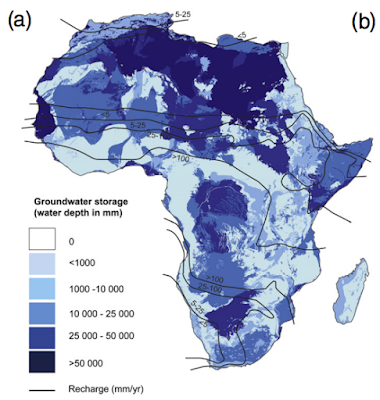I discussed fifteen countries in Sub-Saharan Africa and showed the results of Pavelic et al's book on groundwater. Grouping the region into West, East and South can provide useful insight as they are often either geographically or socially similar.
 |
| Source |
Burkina Faso, Ghana, Mali, Niger and Nigeria are all West African countries largely dominated by Precambrian basement. In such a formation, groundwater tends to collect due to secondary porosity (as opposed to the porosity of the rock itself) due to chemical weathering, fracturing or jointing. Within these spaces is groundwater suitable for use. Aquifers in the crystalline basement rocks generally have the lowest yields ( > 1L/s). Higher yields from boreholes tend to be from sedimentary aquifers (> 20L/s).
In this region, most groundwater is used for drinking water. Regarding how the water is used, 'Drinking water supplies sourced from groundwater for rural/small towns serve 33 percent of Ghana, 92 percent of Niger, 70 percent of Nigeria and 55 percent of Mali. Burkina Faso uses groundwater as the principal source of supply in small towns and rural areas.' This is especially important for populations living in the Sahelian zone who experience infrequent and variable rains.
 |
| Source |
Contrastingly, the basement of Malawi, Mozambique, South Africa, Zambia and Zimbabwe in Southern Africa is predominantly crystalline. Groundwater tends to collect in fractured bedrock and weathered regolith. The groundwater aquifers in Southern Africa tend to be relatively poor due to low capacity and water quality. There are some boreholes with higher yields (>80L/s), such as the Limpopo basin and Zambian/Zimbabwean limestone aquifers, but the majority is poor.
Again, most groundwater is used for drinking, although some is used for remote mining activities. Drinking water supplies sourced from groundwater for rural/small towns serve 51 percent of Zambia, 70 percent of Zimbabwe, 65 percent of Malawi, 60 percent of Mozambique and 60 percent of South Africa'. Groundwater irrigation demand has been increasing, such as in the area around Lusaka, Zambia. The negative impacts around Lusaka have been well documented, and I might look into it in a later post.
 |
| Source |
Similar to South Africa, the countries studied in East Africa have low groundwater reserves. Kenya, Somalia, Tanzania, Uganda and Ethiopia sit atop a Precambrian basement complex. On top of this are new, younger formations than hold groundwater reserves. The rifts and fractures in volcanic highlands and alluvial valleys have very productive aquifers, although shallow. The highest yields in East Africa are about 6L/s, relatively low compared to the other two regions.
Of the regions, groundwater irrigation use in East Africa is the lowest. Groundwater irrigation is a key source of water, especially in some arid areas where it is the only source. 'Drinking water supplies sourced from groundwater for rural/small towns serve 85 percent of Ethiopia, 50 percent of Kenya, 70 percent of Somalia, 56 percent of Tanzania and 70 percent of Uganda.' Large swathes of East Africa are in the Sahel region that only receive rainfall once a year due to the ITCZ circulation (see here for explanation). As such, during the dry season, and especially if the rains fail, groundwater is of utmost importance.
 |
| Source |
All three regions discussed use groundwater significantly and without it the land probably could not sustain the populations it does. As promised, next I'm going to look at Ghana.








